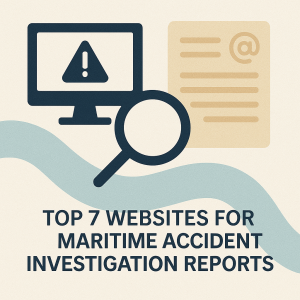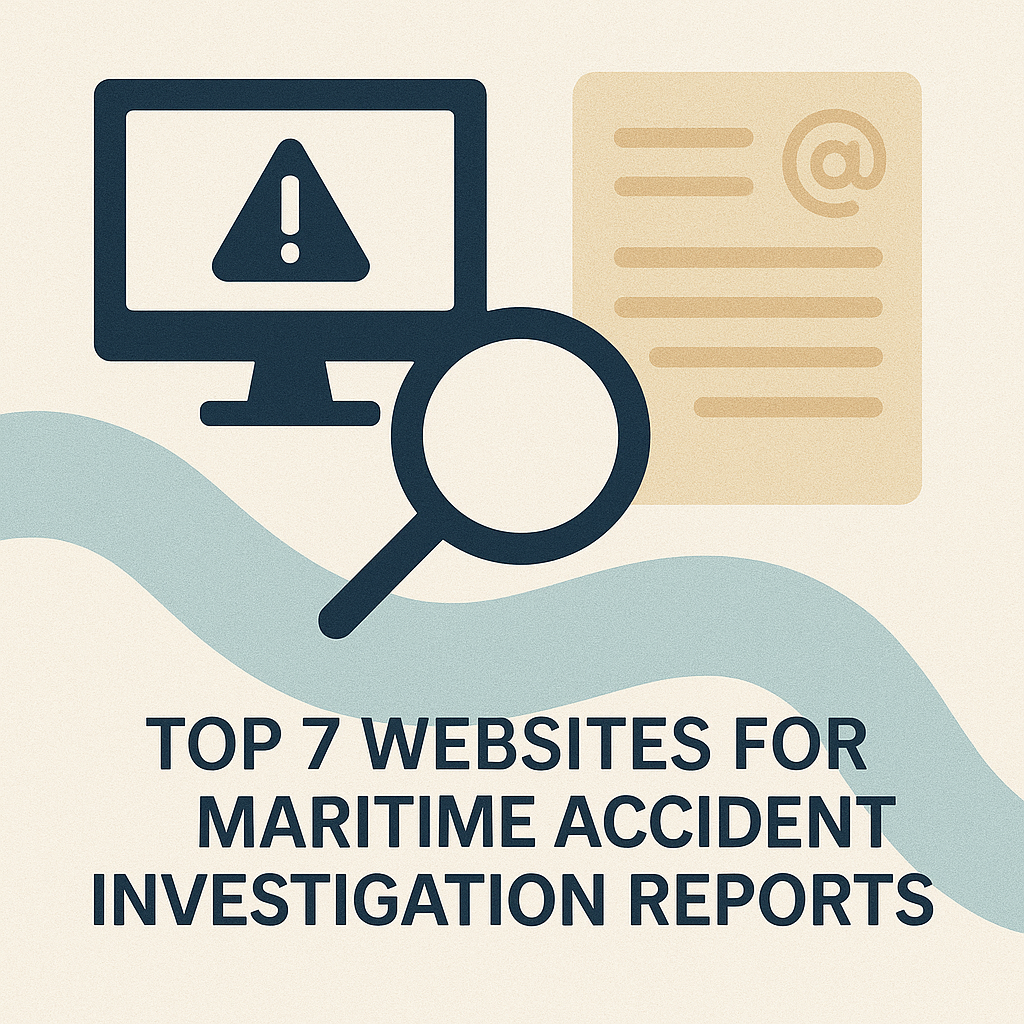Discover the top websites offering trusted maritime accident investigation reports. Explore how these platforms support safety, transparency, and regulatory compliance in global shipping.

Why Maritime Accident Reports Matter in Today’s Shipping Industry
Maritime transportation accounts for over 80% of global trade volume, according to the International Maritime Organization (IMO). Yet, when ships face collisions, fires, machinery failures, or environmental spills, the consequences can be fatal—not just for human lives but also for marine ecosystems, economies, and reputations.
This is where maritime accident investigation reports play a crucial role. These documents—often compiled by national maritime authorities or international maritime bodies—contain insights that help us understand what went wrong, why it happened, and how such incidents can be prevented in the future. They also serve as key references for port state control, insurance investigations, classification society recommendations, and crew training.
But where can professionals, students, and safety officers reliably access these critical reports? In this article, we explore the top 7 websites globally that provide open-access or professionally curated maritime accident investigation databases.
1. The International Maritime Organization (IMO) GISIS Platform
The IMO’s Global Integrated Shipping Information System (GISIS) is a goldmine for anyone researching maritime safety incidents. While not all countries upload full reports here, GISIS remains the most internationally recognized portal for maritime casualties.
Key Features:
-
Public module for Marine Casualty and Incident Reports
-
Advanced filtering by flag state, IMO number, ship type, or incident type
-
Consolidates information submitted under IMO Casualty Investigation Code (MSC-MEPC.3/Circ.3)
Real-World Use:
For example, the 2020 Wakashio grounding off Mauritius had its preliminary investigation posted through GISIS, allowing for early transparency and global discussion.
👉 Visit: IMO GISIS Platform
2. UK’s Marine Accident Investigation Branch (MAIB)
The MAIB is one of the most respected maritime investigation bodies in the world, renowned for its rigorous analysis and educational value.
Key Features:
-
Full-text accident investigation reports, safety digests, and safety bulletins
-
Archive dating back to 1992
-
Focus on UK-flagged or UK waters-related incidents
Example:
The MAIB’s detailed report on the 2015 Cemfjord sinking (a cement carrier that capsized in the Pentland Firth) is now a case study in many maritime colleges.
👉 Visit: MAIB Website
3. United States National Transportation Safety Board (NTSB) – Marine Division
Though the NTSB is known for air and rail safety, its Marine division also publishes comprehensive accident investigations on U.S. waters or U.S.-registered vessels.
Highlights:
-
Independent, non-regulatory voice
-
Reports often include animation simulations and high-quality technical appendices
-
Focuses on merchant marine, fishing vessels, and tugs
Notable Case:
The NTSB’s report on the El Faro sinking in 2015 remains a landmark in maritime human factors analysis.
👉 Visit: NTSB Marine Accidents
4. Australian Transport Safety Bureau (ATSB) – Marine
The ATSB oversees investigations across multiple modes of transport, including marine incidents involving Australian-registered vessels or those in Australian waters.
Features:
-
Emphasis on root cause analysis and proactive safety actions
-
User-friendly search filters by vessel name, date, and type
-
Aligned with Australia’s Navigation Act 2012
Real-World Insight:
Their 2018 report on a fire aboard the livestock carrier Ming Dynasty influenced changes to fire detection systems in livestock transport vessels.
👉 Visit: ATSB Marine Reports
5. Transport Safety Investigation Bureau (TSIB) – Singapore
The TSIB, operating under Singapore’s Ministry of Transport, offers highly detailed and accessible accident reports on both domestic and international incidents involving Singapore-flagged vessels.
Strengths:
-
High focus on navigational safety, crew management, and equipment performance
-
Reports downloadable in PDF with clear timelines and root causes
-
Integrates lessons learned with IMO conventions
👉 Visit: TSIB Maritime Reports
6. European Maritime Safety Agency (EMSA) – EMCIP Database
EMSA’s European Marine Casualty Information Platform (EMCIP) compiles data from EU member states under Directive 2009/18/EC.
Why It Matters:
-
Centralized EU-wide platform for accident reporting
-
Statistical dashboard, anonymized summaries, and trend analysis tools
-
Access for authorized users; public reports vary by country
Institutional Use:
Port state control authorities and classification societies across Europe rely on EMCIP data for predictive safety modeling.
👉 Visit: EMSA EMCIP Info
7. Canada Transportation Safety Board (TSB) – Marine Reports
Canada’s TSB maintains a transparent, searchable online archive of marine accident reports affecting Canadian waters or vessels.
Features:
-
Executive summaries and recommendations for both commercial and non-commercial shipping
-
Frequently includes human factors and training issues in its conclusions
-
Public access to marine safety advisories and updates
Noteworthy Report:
The 2017 grounding of the Nathan E. Stewart tug in British Columbia highlighted risks in towing operations under fatigue and weather stress.
👉 Visit: TSB Marine Reports
–
Case Studies: How These Reports Drive Real-World Change
Safety Management System Overhauls
After the El Faro disaster, the NTSB’s findings on weather routing and company oversight led to revised SMS protocols across many U.S.-flagged operators.
Classification Society Adjustments
MAIB’s reports have previously triggered updates in Lloyd’s Register and DNV class notations, especially regarding emergency escape routes and watertight door integrity.
IMO and STCW Amendments
Some fatal incident investigations have influenced amendments to STCW training tables, particularly in bridge resource management (BRM) and engine room communication protocols.
Challenges and Developments in Accessing Maritime Reports
Despite the importance of accident transparency, several challenges persist:
- Inconsistent Reporting Standards: Not all flag states comply fully with IMO’s Casualty Investigation Code.
- Restricted Public Access: Some databases like EMCIP are partially restricted.
- Language Barriers: Reports from non-English-speaking countries are often unavailable in global lingua franca.
Recent developments in machine translation, data sharing APIs, and IMO’s push for digitalization may improve access in the coming years.
Frequently Asked Questions (FAQ)
What is a maritime accident investigation report?
It is a formal document compiled by an authorized body that analyses the cause of a maritime incident, with recommendations for future prevention.
Who uses these reports?
Shipowners, port state control officers, classification societies, insurance underwriters, maritime academies, and safety regulators.
Are all reports publicly available?
Not all. Availability depends on national laws, the sensitivity of the case, and IMO reporting practices.
Can these reports be used in legal proceedings?
Often yes, but primarily they are for safety learning. Some are inadmissible in court depending on jurisdiction.
Do they cover crew errors?
Yes. Many reports include human error analysis, fatigue assessment, training gaps, and communication issues.
How often are reports released?
Typically, reports are issued 6–18 months post-incident depending on complexity and jurisdiction.
Are there academic uses for these reports?
Absolutely. They are used in safety case modeling, human factors research, and as training material in IMO Model Courses.
Conclusion: A Path to Safer Seas
Maritime accident investigation reports are more than technical documents—they are lifelines to a safer, more transparent industry. Whether you’re a cadet learning bridge procedures or a safety manager auditing risk systems, these reports offer real-world knowledge grounded in experience and evidence.
Bookmarking the top 7 websites highlighted here can help you stay updated, informed, and prepared to act in the spirit of maritime safety and continuous learning.

